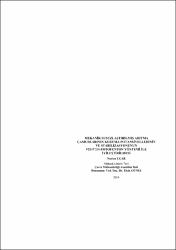| dc.contributor.author | Uçar, Nurten | |
| dc.date.accessioned | 2017-04-27T11:32:44Z | |
| dc.date.available | 2017-04-27T11:32:44Z | |
| dc.date.issued | 2014 | |
| dc.identifier.uri | https://hdl.handle.net/20.500.11776/509 | |
| dc.description.abstract | Arıtma çamurları son yıllarda Türkiye‘de ve dünyada önemli bir çevre sorunu haline gelmiştir. Arıtma çamurlarının kaynağı evsel ve endüstriyel atıksulardır. Bu suların arıtımı sırasında oluşan çamur miktarı çevre standartları arttıkça artmaktadır. Son yıllarda arıtma çamurunu uzaklaştırma yöntemi yerine yeniden kullanım çalışmaları üzerine yoğunlaşılmıştır. Bu çalışmanın amacı, arıtma çamurlarının stabilizasyonunun ve dezentegrasyonunun sağlanarak çevreye daha az zarar verecek hale getirilmesinin sağlanmasıdır. İleri oksidasyon yöntemleri, çamur içindeki organik maddeleri oksitleyerek, bozunma eğilimi daha az bir bileşen haline getirir. İleri oksidasyon yöntemlerinden en çok kullanılan proseslerden biri de Fenton prosesidir. Fenton prosesinin UV ışık ile kombine edildiği FotoFenton prosesi de kullanılmaktadır. Bu çalışmada, Çerkezköy Organize Sanayi Bölgesinden (ÇOSB), gıda ve tekstil endüstrisinden alınan arıtma çamurları kullanılmıştır. FeSO47H2O ve H2O2 miktarı, pH, reaksiyon süresi, çamurda bulunan su içeriği gibi parametreler değiştirilerek en yüksek UKM ve KOİ giderimi elde edilmeye çalışılmıştır. Bunun yanında çamur kuruma hızı da stabilize çamur elde etmede etken olduğu için, bu parametre de dikkate alınmıştır. En yüksek UKM ve KOİ gideriminin sağlandığı Fenton reaksiyonu koşulları gıda endüstrisi çamuru için 0,791 g H2O2-4,188 mg Fe+2/g çamur, 3 mL distile su ilavesi ve 6 saat reaksiyon süresiyle sağlanmıştır. ÇOSB çamuru için, 0,989 g H2O2-4,188 mg Fe+2/g çamur, pH 3, 3 mL su ilavesi, 6 saat reaksiyon süresi ve 30oC sıcaklık değerinde sağlanmıştır. Tekstil endüstrisi çamuru için, 6,026 mg Fe+2 -1,384 g of H2O2/g çamur, pH 3, 2 mL distile su ilavesiyle sağlanmıştır. UV ışığın etkisini gözlemlemek için UVA, UVB, UVC ışıkla Fenton reaksiyonu uygulanmıştır. Foto-Fenton reaksiyonu Fenton reaksiyonuna göre daha etkili bir uygulamadır. Foto-Fenton işleminde UKM, KOİ gidermede en etkili UVC ışık bulunmuştur. | en_US |
| dc.description.abstract | Sewage sludge has become an important environmental issue in recent years for Turkey and the world. The sources of sewage sludge are domestic and industrial wastewaters treatment plants. The amount of sludge formed during the treatment of wastewater increases with increasing severity of environmental standards. In recent years, the efforts has focused on reuse of sludges instead of disposal. The purpose of this study is stabilisation and disintegration of the wastewater treatment sludges to ensure that gives less damage to environment. Advanced oxidation processes provide to oxidize organic matter in sludge and the components in the sludge becomes less degradable. Fenton and photo-Fenton processes are the most widely used processes in advanced oxidation methods. In photo-Fenton process, Fenton process is combined with UV light. In this study the sludges of Cerkezköy Organized Industrial Zone (COSB), food industry and textile industry were used. In the study we changed the concentration of FeSO47H2O and H2O2, pH, reaction time and water content to obtain the highest volatile solids (VS) and chemical oxygen demand (COD) removal rates. Additionally, we examined the sludge drying rates as a factor of obtaining the stabilized sludge. The highest VS and COD removal rates resulting in Fenton reaction conditions for food sludge were 0,791 g H2O2- 4,188 mg Fe+2/g sludge, 3 mL distilled water and 6 hours reaction time. For COSB sludge, 0,989 g H2O2-4,188 mg Fe+2/g sludge, pH 3, 3mL of water, 6 hours reaction time and 30°C temperature were provided. For textile industry sludge, 6,026 mg Fe+2 -1,384 g of H2O2/g sludge, pH 3 by the addition of 2 mL distilled water were provided. To observe the effect of UV light UVA, UVB, UVC light was applied with Fenton reactions. Photo-Fenton reaction by the Fenton reaction was more effective application. UVC light was found the most effective for VS and COD removal rates in photo-Fenton process. | en_US |
| dc.language.iso | tur | en_US |
| dc.publisher | Namık Kemal Üniversitesi | en_US |
| dc.rights | info:eu-repo/semantics/openAccess | en_US |
| dc.subject | Arıtma çamuru | en_US |
| dc.subject | Fenton | en_US |
| dc.subject | Foto-Fenton | en_US |
| dc.subject | Dezentegrasyon | en_US |
| dc.subject | Sewage sludge | en_US |
| dc.subject | Fenton | en_US |
| dc.subject | Photo-Fenton | en_US |
| dc.subject | Disintegration | en_US |
| dc.title | Mekanik susuzlaştırılmış arıtma çamurlarının kuruma potansiyellerinin ve stabilizasyonunun fenton-fotofenton yöntemi ile iyileştirilmesi | en_US |
| dc.title.alternative | The potential of drying and stabilization of the mechanically dewatered sludge improvement by the method of fenton-photofenton | en_US |
| dc.type | masterThesis | en_US |
| dc.department | Enstitüler, Fen Bilimleri Enstitüsü, Çevre Mühendisliği Ana Bilim Dalı | en_US |
| dc.relation.publicationcategory | Tez | en_US |



















